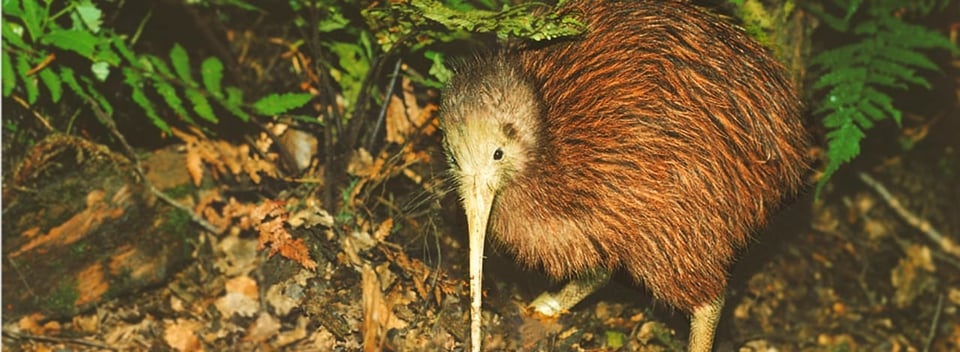
Conservation in New Zealand – Protecting New Zealand’s Kiwi Bird

The kiwi bird is New Zealand’s beloved national icon. As New Zealander’s, we refer to ourselves as “Kiwis”, and are very fond of our fluffy flightless namesakes. So what makes these birds so special, what are we doing to protect them, and how can you go about seeing one for yourself?
The New Zealand Kiwi Bird
Kiwi are endemic to New Zealand, meaning they are not found anywhere else in the world. They are members of the ratite family, which includes birds such as ostriches and emus. Kiwi are considered taonga to Maori, a sacred treasure. Members of high rank in Maori communities, such as chiefs, wear cloaks made from kiwi feathers called kahukiwi, indicating the mana (the status, prestige and importance of an individual) of the person within their family, and the respect and importance Maori place on kiwi.
Kiwi have very unique survival adaptations as they are flightless and mostly blind, and therefore heavily reliant on their senses of smell and touch in their beaks as well as their hearing. They have very long beaks, at the end of which are their nostrils (kiwi are the only birds known to have nostrils) with which they hunt for prey and detect predators.
How big is a kiwi?
Kiwi are approximately the size of a domestic chicken, but range in size from about 25-45cm tall. The size of their eggs, however, differ greatly from a chicken’s and are one of the features that make kiwi so unique. A kiwi egg is roughly 25% of the size of the female’s body, make it one of the largest eggs proportionate to body size of any species of bird in the world. The kiwi also has the smallest eye in relation to body size of all bird species, giving them a very small visual field.
Are kiwi nocturnal?
Although they are generally considered to be nocturnal creatures, it is thought that this was likely an adaptation that kiwi gained in order to avoid introduced predators. Kiwi that live in predator controlled areas or sanctuaries are often seen in daylight, indicating that they are only nocturnal out of necessity rather than by nature.
How many kiwi are there left?
The current population of kiwi is about 68,000, with more than half of these being the North Island brown kiwi. It is estimated that prior to humans arriving in New Zealand, kiwi populations were approximately 12 million, and their populations only dropped below 1 million in the early-mid 1900s. This rapid decline and near-extinction in the past 100 years is a sobering reminder of the devastation caused by introduced predators and the importance of our conservation programs.
Species of Kiwi

Roroa/Great Spotted Kiwi
Roroa are the largest species of kiwi, standing about 45cm/18in tall. The lighter bands of feathers within its brown plumage look like spots, giving the roroa its English name of Great Spotted Kiwi. There are estimated to be about 20,000 Great Spotted Kiwi, living mostly in the mountains of Kahurangi National park and the Southern Alps.
Little spotted kiwi
The little spotted kiwi have similar plumage to the great spotted kiwi, however as the name suggests, are much smaller in size at around 25cm/9.8in tall. Due to its small size, these kiwi are especially susceptible to predation from stoats, cats and dogs which lead to their extinction on the mainland. The majority of the remaining little spotted kiwi population live on Kapiti Island, located off the coast north of Wellington with about 1350 kiwi on the island. Breeding programs on other offshore islands have been proving successful as well, with small populations of 50 or so little spotted kiwi on several predator-free islands.
Tokoeka/Southern Brown Kiwi
The tokoeka, or southern brown kiwi, are almost as big as the great spotted kiwi but have a more uniform brown plumage. These kiwi are found in the southern parts of the south island, with populations found on Stewart Island, Fiordland and in the Haast Range of the Southern Alps.
North Island Brown Kiwi
North Island brown kiwi are similar in size to their southern counterparts but can be identified by their streaky red-brown plumage. These kiwi differ in that they lay two eggs per year, unlike other species which only lay one. The north island brown kiwi has proved to be the most resilient of the kiwi species, and has been able to adapt to a wide range of habitats. With a population of about 35,000 they are the most populous species of kiwi.
Rowi/Okarito Brown Kiwi
The rowi are the newest species of kiwi, having only been identified as a distinct species in 1994. Now found only in Okarito, a small coastal area on the West Coast of the South Island, this species’ numbers have dwindled to only around 450 individuals, and have only survived thanks to conservation programs. They were once found throughout the West Coast and in the lower half of the North Island but have been heavily affected by introduced predators. The rowi is the only species of kiwi to lay three eggs per year, and each egg is laid in a different nest.
What are the major predators and threats to kiwi?
Kiwi numbers are threatened by introduced predators and human impacts. New Zealand did not have any land mammals other than a native bat before early settlers arrived, bringing with them domesticated animals as well as unintended pests such as rats and mice which hitched rides on their ships. Native birds such as the kiwi did not have appropriate defence mechanisms and survival adaptations to protect themselves from such mammalian predators and have therefore suffered greatly since their introduction.
Kiwi can live for between 25 and 50 years, although outside of protected wildlife sanctuaries, many do not live their full life expectancy due to predation by introduced pests. In fact, 2% of the kiwi population outside of kiwi protection zones die each year, and only 5-10% of kiwi chicks survive in unmanaged areas, reinforcing the huge importance of kiwi conservation programs. The biggest threat to kiwi populations are stoats, which kill kiwi chicks and are responsible for 50% of kiwi chick deaths on the mainland of New Zealand. Domestic cats and dogs also kill both chicks and adult birds. Kiwi do not have a sternum bone, making them particularly susceptible to crushing injuries. These types of injuries are easily caused by dogs as even a playful push can be enough to cause catastrophic injury. Life expectancies of kiwi have plummeted by half in areas with high populations of dogs.
Kiwi conservation efforts – how are we protecting kiwi populations?
Without diligent predator management, wildlife sanctuaries and dedicated breeding programs, kiwi numbers would be continuing to drastically decline. Five kiwi sanctuaries were introduced in 2000 by the Department of Conservation to protect kiwi and help to stimulate their population growth, one for each of the five kiwi species. Many offshore islands dotted around the New Zealand coast are protected wildlife sanctuaries where predators have been eliminated and surveillance trapping ensures that any that do make their way onto the island are eliminated quickly. Kiwi are translocated to these islands and once their populations have increased sufficiently, are re-released back into controlled areas of the mainland. There are also a number of mainland conservations islands where fences and extensive predator monitoring and trapping allow kiwi to live with minimal threat of predation.

Operation Nest Egg
Operation Nest Egg is the largest kiwi breeding program in New Zealand, and involves removing kiwi eggs and chicks from the wild and hatching and raising them in captivity until they are big enough to fend for themselves in the wild. The Operation Nest Egg program increases a kiwi chick’s chances of survival to adulthood from 5% to 65%. Many kiwi sanctuaries around the country including the 10 listed below in 'Where can I see a Kiwi' have joined the Operation Nest Egg program.
The National Kiwi Hatchery
Rainbow Springs in Rotorua operates an extensive kiwi hatching program which has grown to become the largest and most successful hatching facility in the country. The National Kiwi Hatchery receives eggs from 15 sanctuaries and reserves throughout the North Island and has hatched over 2000 eggs.
Are conservation efforts to protect kiwi working?
Protection and breeding programs in recent years have enabled two of the five kiwi species to be reclassified as vulnerable rather than endangered in 2017, a great milestone in kiwi conservation efforts. Without these efforts, kiwi populations would decline until they joined the ranks of the many extinct native New Zealand bird species. Experts estimate that without the ongoing conservation programs, our special kiwi birds would go extinct in the wild within two generations. While we have slowed the decline in population of some species, and other species have started to increase in population again, there is still a lot of work to do to ensure that our beloved national bird survives for generations to come.
Where can I see a Kiwi?
The easiest way to see a kiwi, and to help kiwi conservation efforts by supporting the organisations that are working hard to protect them, is to visit one of the many kiwi sanctuaries throughout the country. These are the 10 best places to see kiwi in New Zealand, in order of their location in the country from North to South:
- Rotoroa Island (1.5hr ferry ride from Auckland)
- Maungatautari Sanctuary Mountain
- Rotorua - Rainbow Springs National Kiwi Hatchery
- Otorohanga Kiwi House
- Pukaha National Wildlife Centre
- Kapiti Island
- Wellington – Zealandia
- Christchurch – Willowbank Wildlife Reserve
- Franz Josef – West Coast Wildlife Centre
- Rakiura/Stewart Island
Where is the best place to see kiwi in the wild?
For the unique experience of seeing a kiwi in the wild, the best place to go is Rakiura/Stewart Island. Due to extensive predator control, Stewart Island is one of the few places where kiwi are often seen during the day time. Kiwi spotting tours operate on the island regularly, and the local experts know the best places to visit to give the best chances of spotting kiwi in their natural habitat.
Join our New Zealand Great Walk Adventure Tour to experience the unique Stewart Island and enjoy a nighttime Kiwi Spotting Tour where you will hopefully see a tokoeka southern brown kiwi. REQUEST A FREE COPY OF OUR BROCHURE HERE, or get in touch for more information about our tours!








Comments
Let’s talk – we’d love to hear what you think. Pop your details in below and have your say.
No one has commented on this page yet.
RSS feed for comments on this page | RSS feed for all comments